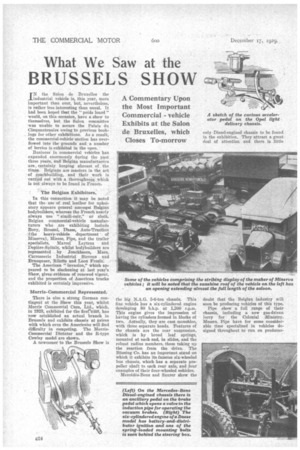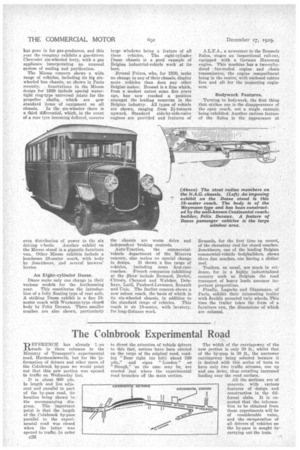What We Saw at the
Page 46

Page 47

Page 48

If you've noticed an error in this article please click here to report it so we can fix it.
BRUSSELS SHOW
A Commentary Upon the Most Important Commercial vehicle Exhibits at the Salon de Bruxelles, which Closes To-morrow
IN the Salon de Bruxelles the industrial vehicle is, this year, more important than ever, but, nevertheless, is rather less interesting than usual. It had been hoped that the " poids lourd " would, on this occasion, have a show to themselves, but the Salon committee was unable to secure the Palais du Cinquantetiaire owing to previous bookings for other exhibitions. As a result, the commercial-vehicle section has overflowed into the grounds and a number of lorries is exhibited in the open.
Business in commercial vehicles hat expanded enormously during the past three years, thid TBelglan manufacturers are, certainly keeping abreast of. the times. Belgians are masters in the art of coachbuilding, and their work is carried out with a thoroughness which is not .always to be found in France.
: The Belgian Exhibitors. : In this connection it may be noted that the use of real leather for. upholstery appears general. amongst Belgian bodybuilders, whereat the French nearly always use " simili-cuir," or cloth. Belgian commercial-vehicle manufacturers who are exhibiting include Bony, .Brossel, Dasse' Auto-Traction [(the heavy-vehicle department •. ot Minerva), Miesse, Pipe, and the trailer specialists, Marcel Leytens and Depire-SpitaIs, whilst hodYbuilders are represented by Jenckheere, Mass, Carrosserie Induttricl Stevens and Branquser, Rilette and Leon Fresiti:
The American "invasion," which appeared to be slackening at last year's Show, gives evidence of renewed vigour, and the proportion of American trucks exhibited is certainly impressive.
Morris-Commercial Represented.
There is also a strong German contingent at the Show this year, whilst Morris Commercial Cars, Ltd, which, in 1928, exhibited for the firsrraiiiT, has now established an actual branch in Brussels and exhibits chassis at prices with which even the Americans will find diffieulty in competing. The MorrisCommercial Dictator and the R-type Cowley model are shown.
A newcomer to the Brussels Show is
the big N.A.G. 5-(i-ton chassis. This fine vehicle has a six-cylindered engine developing 80 b.h.p. at 1,200 r.p.m. This engine gives the impression of having the cylinders formed in blocks of two. Actually, they are east monobloc, with three separate heads. Features of the chassis are the rear suspension, which is by broad leaf springs, mounted at each end, in slides, and the robust radius members, these taking up the reaction from the drive. The Bussing Co. has an important stand on which it exhibits its famous six-wheeled but chassis, which has a separate propeller shaft to each rear axle, and four examples of their four-wheeled vehicles.
Mercedes-Benz and Saurer show the only Diesel-engined chassis to be found in the exhibition. They attract a great deal of attention and there is little doubt that the Belgian industry will soon be producing vehicles of this type.
Pipe show a full range of their chassis, including a new gas-driven lorry for the Colonial Ministry. Messrs. Pipe have for some considerable time specialized in vehicles designed throughout to run on producer gas, and hundreds of these lorries are working with success in Belgian Congo
territory. The .Pipe producer. has this
year been entirely redesigned. A generator of the inverted type, in which the air enters at the top, is now employed. and the introduction of water vapour into the gas has been abandoned. Great attention has been paid to the cooling of the gas, this being generated at an extremely high temperature. This temperature, incidentally, is of considerable advantage in the Congo district, where the available charcoal fuel is often dirty and of poor quality.
From the dustbox at the bottom of the generator the gas passes through a
number of transverse tubes to a second dusthox on the opposite side of the chassis, both .containers being, . easily accessible for cleaning purpoles. The gas then enters the scrubber, a cylindrical steel box containing a number of concentric cylinders, which are made of fine-mesh 'wire gauze. These gauze cylinders are attached to the outer casing by springs and are kept in constant vibration when the lorry is . moving, thus shaking free any dust particles which may lodge in the gauze.
The gas enters the central cylinder Cud works outward, finally passing
through a cylindrical fabric filter. Between the filter and the engine the gas undergoes a further cooling process, being conducted through a series of pipes, which runs backward and forward for the whole length of the chassis. Like most producer-gasappliances, the Pipe outfit is designed for starting up on petrol, but the starting arrangements are distinctly original.
A special form of valve controls the supply of petrol vapour and gas to the engine. At the outset petrol is delivered to the two middle cylinders and charcoal gas to the end ones. When the engine has been running for two or three minutes the -control lever is pushed over to "full gas" and all four cylinders receive the charcoal product. Th,e operation of this valve, which may be controlled from the driver's seat, is interconnected with that of the advance and retard of the magneto, so that the spark position automatically adjusts itself to the conditions of thenionient.
A feature of the Pipe gas-driven vehicles is the provision of splash lubrication, in addition to the ordinary pressure system, so that in the event of an oil-pump breakdown the engine shall continue to work, even when driven
a native.
Details of Other Pipe Exhibits.
In addition to their gas-driven lorries, Messrs. Pipe exhibit a range of 3-ton and 4-ton petrol vehicles, a special feature of all the colonial models being the large oil radiator, which is situated in front of the ordinary water radiator. Particularly large-diameter pipes carry the oil from the pump to the radiator and back through the filter.
An innovation this year is the introduction of one-shot pressure greasing, which has been standardized for all chassis. The 2i-ton gas-driven colonial model Pipe has a 100 mm. by 180 mm. four-cylindered engine, developing on gas 45-50 b.h.p. at 1,800 r.p.m.
Marcel' Leytens, the trailer specialist,
has gone in for gas-producers, and this year the company exhibits a gas-driven Chevrolet six-wheeled lorry, with a gas appliance incorporating an unusual system of cooling and purification.
The Miesse concern shows a wide range of vehicles, including its big sixwheeled bus chassis, as shown in Paris recently. Innovations in the Miesse design for 1930 include special watertight ring-type universal joints for the propeller shafts, which are now standard items of equipment on all chassis. In the six-wheeler there is a third differential, which, in the event of a rear tyre becoming deflated, misnris3 even distribution of power to the six
driving v-heels. Another exhibit on the Miesse stand is a gigantic furniture van. Other Miesse exhibits include a handsome 28-seater coach, with body by Jonckheere, and several brewers' lorries.
An Eight-cylinder Dasse. Dasse make only One change in their various models for the forthcoming year. This constitutes the introduction of a fully floating type of rear axle. A striking Dasse exhibit is a fine ISseater coach with Weymann-type closed body by Felix Devanx. Three smaller coaches are also shown, particularly
large windows being a feature of all these vehicles. The eight-cylinder Dasse chassis is a good example of Belgian industrial-vehicle work at its best Brossel Freres, who, for 1930, make no change in any of their chassis, display more vehicles than does any other Belgian maker. Broasel is a firm which, from a modest outset some five years ago, has now reached a position amongst the leading concerns in the Belgian industry. All types of vehicle are shown, ranging from 2i-tonners upward. Standard side-by-side-valve engines are provided and features of the chassis are worm drive and independent braking controls.
Auto-Traction, the commercial'vehicle department of the Minerva concern, also makes no special change
in design. It shows a fine range of vehicles, including some first-rate coaches. -French companies exhibiting at the Show include Bernard, Berliet, Citro611, Chenard and Waleker, Delahaye, Latil, Panhard-Levassor, Renault and Unic. The Berliet concern shows a new saloon coach, the basis of which is its six-wheeled chassis, in addition to the standard range of vehicles. This coach is •an 18-seater, with lavatory, for Ion g-distance work.
A.L.F.A., a newcomer to the Brussels Salon, stages an inspectional rail-ear, equipped with a German Hanomag engine. This machine has a two-eylindered . fan-cooled engine and chain transmission, the engine compatiment being in the centre, with enclosed cabins fore and aft for the insPecting engineers.
Bodywork Features.
Turning to bodywork, the first thing that strikes one is the disappearance of the open coach, not a single example being exhibited. Another curious feature of the Salon is the appearance at
Brussels, for the first time on record, of the clerestory roof for closed coaches_ Jonckheere, one of the leading Belgian commercial-vehicle bodybuilders, shows three fine coaches, one having a Slidimoroof.
Trailers, as usual, are much in evidence, for in a highly industrialized country such as Belgium the road transport of heavy loads assumes important proportions.
Lagache and Glazsitiann, of Paris, exhibit their interesting trailer with flexibly mounted twin wheels. This time the trailer takes the form of a furniture van, the dimensions of which are colossal.












































































































